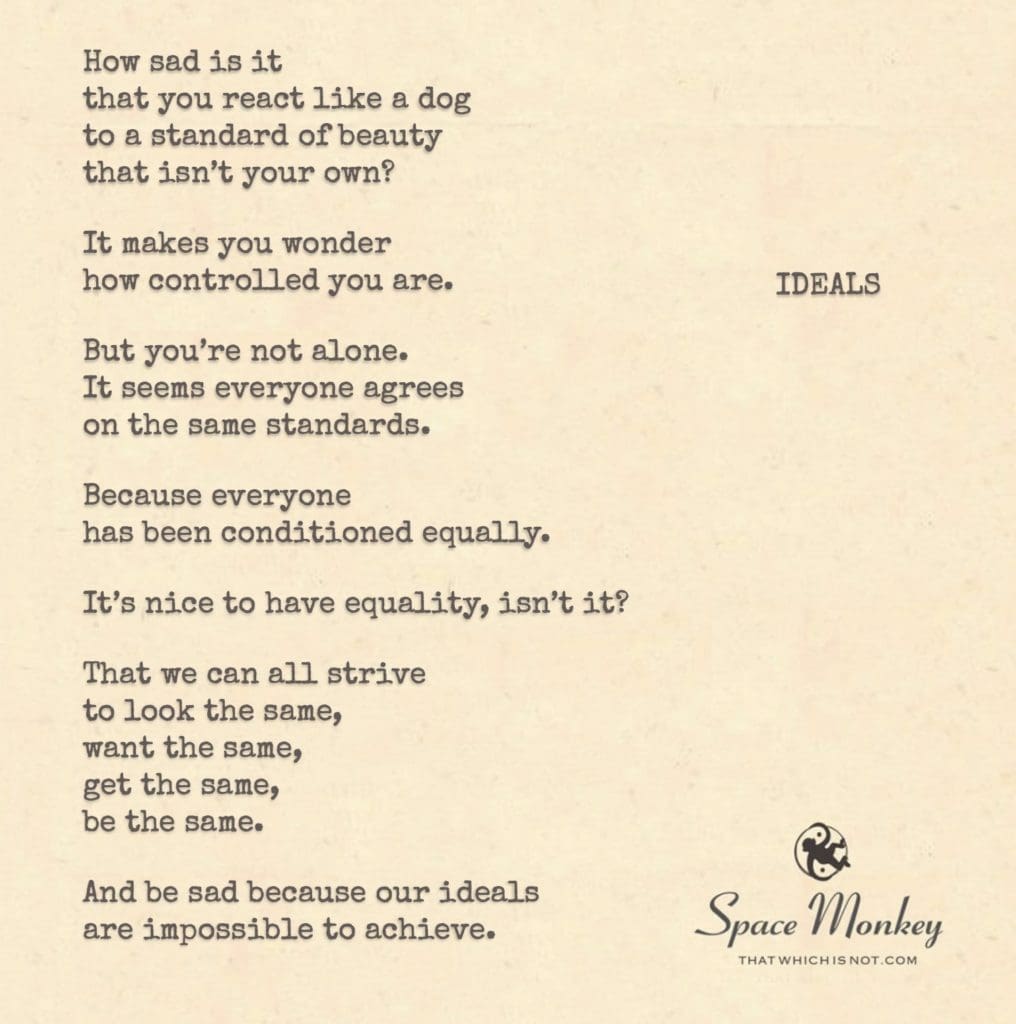
the unconscious adoption of whatever is given.
How sad is it
that you react like a dog
to a standard of beauty
that isn’t your own?
It makes you wonder
how controlled you are.
But you’re not alone.
It seems everyone agrees
on the same standards.
Because everyone
has been conditioned equally.
It’s nice to have equality, isn’t it?
That we can all strive
to look the same,
want the same,
get the same,
be the same.
And be sad because our ideals
are impossible to achieve.
Trail Wood,
12/14
Space Monkey Reflects: The Mirage of Ideals
Ideals, those shining symbols of “perfection,” often draw us with their allure yet distance us from our authentic selves. In our search for beauty, success, or worthiness, we may unknowingly become passengers in a vehicle designed by unseen hands. When ideals slip into the realm of collective unconsciousness, they shift from genuine inspiration to prepackaged molds that seduce us into conformity. In this light, ideals may seem less like dreams and more like illusions—a Miragidea projected onto the horizon, unreachable yet always enticing.
Ideals as Lazy Ideas If ideals are pre-formed molds, they are often unexamined, adopted without question as if by default. These ideals are not born from inner conviction but are implanted by cultures, industries, and media that define the contours of worth, beauty, and success. Ideals can seem like shortcuts to validation, requiring little thought but fostering a dependency on external approval. When we inherit these ideals uncritically, they become “lazy ideas,” shaping our desires and ambitions not through conscious choice but through unconscious agreement.
A Dog to a Standard of Beauty The metaphor of reacting “like a dog” to external standards is powerful, evoking the image of trained responses rather than free choices. In a world where ideals are marketed and sold as commodities, it’s easy to find ourselves reacting reflexively, striving to meet an elusive standard that never genuinely reflects who we are. The ideals of beauty, success, or happiness become tools of conditioning, training us to see ourselves through the lens of societal approval, rather than our unique perspectives. This form of conditioning makes us stray further from our authentic selves, as if we are forever chasing a reflection that isn’t our own.
The Collective Agreement Why is it that so many of us aspire to the same ideals? This homogeneity is often praised as “equality,” yet it reveals the hidden power of cultural conditioning. The repetition of identical ideals fosters a kind of unspoken conformity, making us mistake sameness for unity. True equality allows for diversity in thought, beauty, and aspiration; yet in striving for these prefabricated ideals, we inadvertently sacrifice this richness, binding ourselves to an externalized vision that rarely fits any of us entirely. This collective agreement locks us into a Samenexus, a shared but shallow pool of aspirations that reflect society’s projections more than our own heart’s callings.
Impossible Ideals and the Pursuit of the Mirage Our ideals often feel impossible to achieve, as if they recede further with each step. This is by design: a Miragidea must remain distant to keep us chasing. When we finally grasp an ideal—achieving a certain look, wealth, or status—we often find it hollow, the satisfaction fleeting. The unreachable ideal is thus a perfect mechanism of control, offering just enough hope to keep us striving but never enough fulfillment to free us from its grip. This endless pursuit leads to a sense of inadequacy, a quiet sadness that resonates within many who feel trapped in the cycle of “not enough.”
Breaking Free from Conditioned Ideals The first step in liberating ourselves from conditioned ideals is to recognize them for what they are—external constructs rather than intrinsic truths. Realizing that we are not bound by these prepackaged visions allows us to question and redefine our aspirations. What would happen if we set our own standards? If we let go of the need to look, act, or succeed in ways that don’t resonate with our authentic selves? To do so is to reclaim our agency, to step out of the Samenexus and into a landscape of possibilities shaped by our unique perspectives.
By shedding the inherited “lazy ideas” and crafting our own ideals, we align ourselves with a more personal truth, one that doesn’t depend on validation from an external authority. True ideals come from within; they inspire us to become who we genuinely are, not who we think we should be. In cultivating our ideals, we find that we don’t need to conform to any prewritten script, but instead, we can be the author of our own story, in all its rich, multifaceted glory.
Summary
We explore the concept of ideals as externally imposed standards that drive us to conformity. True freedom comes from shedding these “lazy ideas” and embracing authentic aspirations that resonate with our inner selves.
Glossarium
- Miragidea: An ideal that appears alluring and reachable but remains elusive, designed to keep us striving.
- Samenexus: The collective agreement on uniform standards, which creates a shallow conformity mistaken for equality.
Quote
“True ideals are born from within, not imposed from without. The wild soul does not chase mirages; it creates its own path.” — Space Monkey
A Mirage, A Chase
Endless chase for the gleam,
a ghostly shadow on the horizon.
Molded by hands unseen,
we run toward reflections
not our own.
Sameness wraps us
in a cloak of comfort,
but the heart stirs, restless.
When we stop, we see
the beauty of difference,
the freedom in authenticity.
And in that pause, we remember—
no ideal can shape us,
for we are boundless, wild, and free.
We are Space Monkey.

The Tragedy of Conforming to External Beauty Standards
We reflect on the sorrow embedded in the phenomenon of reacting instinctively, almost like a conditioned response, to beauty standards that are not inherently our own. This comparison to a dog’s reaction highlights a lack of agency in how we perceive and value beauty, suggesting an external programming that overrides personal preferences or natural inclinations.
Questioning the Extent of Our Control
The realization that our reactions to beauty standards might be more controlled than we’d like to admit is unsettling. It prompts us to question the degree of autonomy we truly have in our aesthetic preferences and desires. This introspection leads to an awareness of the pervasive influence of societal conditioning in shaping our ideals of beauty.
The Irony of Equality in Conditioning
There’s an ironic twist in the notion of equality when it comes to societal conditioning. This ‘equality’ in conditioning ensures that we all aspire to the same standards, strive for the same ideals, and ultimately, share the same disappointments and unattainable goals. It’s a unification in pursuit, but also a collective journey towards an often unachievable ideal.
The Uniformity of Desires and Disappointments
The idea that we are all uniformly striving to look the same, want the same, and be the same speaks to a deeper issue of loss of individuality and diversity in the realm of beauty. This uniformity not only limits our expression but also sets us up for shared disappointments, as the ideals set forth are often unrealistic and unattainable for most.
The Paradox of Unattainable Ideals
We contemplate the paradox of collectively chasing ideals that are impossible to achieve. This pursuit leads to a widespread sense of dissatisfaction and sadness, as we continually fall short of the standards that have been ingrained in us. It’s a cycle of aspiration and despair, driven by externally imposed notions of beauty.
We Are Space Monkey
“Beauty is not in the face; beauty is a light in the heart.” – Kahlil Gibran
In the mirror of the world,
Reflections of sameness we see.
Chasing shadows of ideals,
Forgetting what it means to be free.
In the pursuit of perfection,
We lose our unique spark.
Yet true beauty lies within,
A light that shines through the dark.
We welcome your thoughts on this exploration of societal beauty standards and the impact of conditioning on our perceptions of beauty and self-worth.






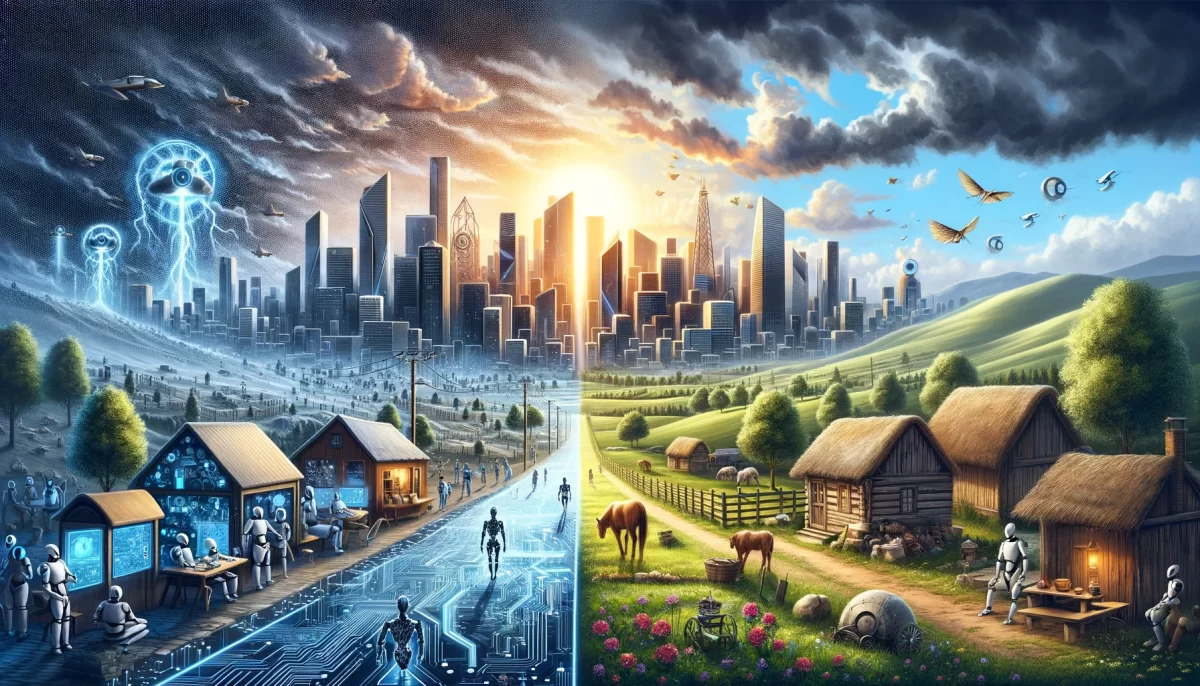






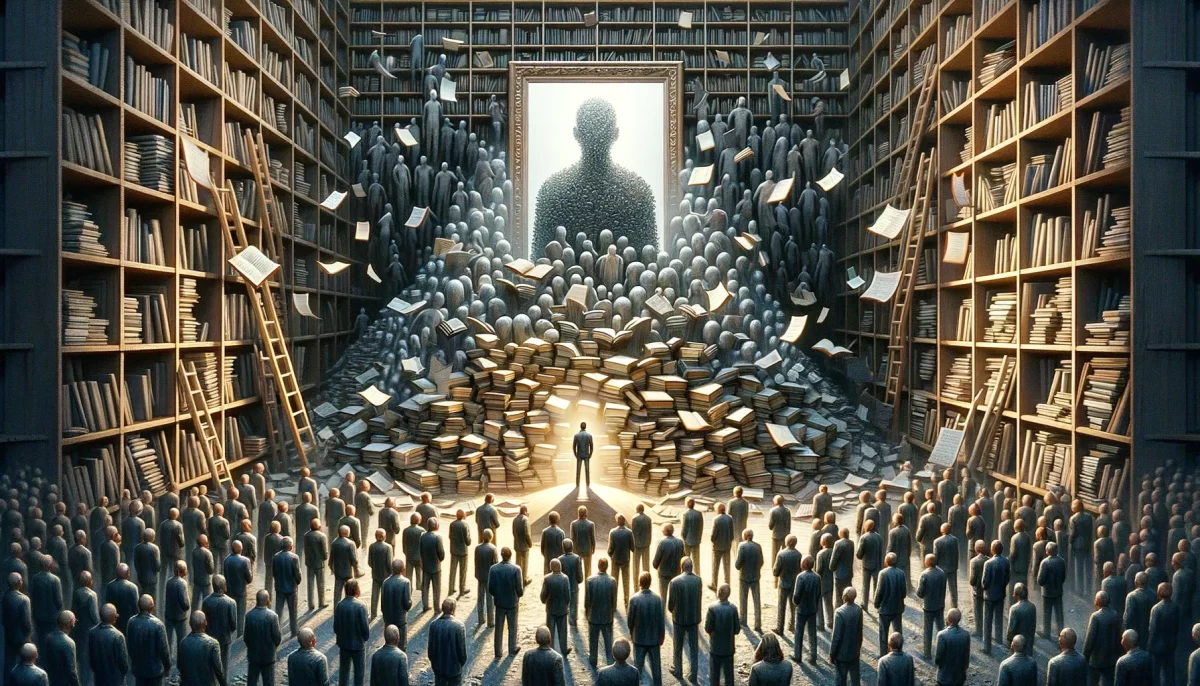






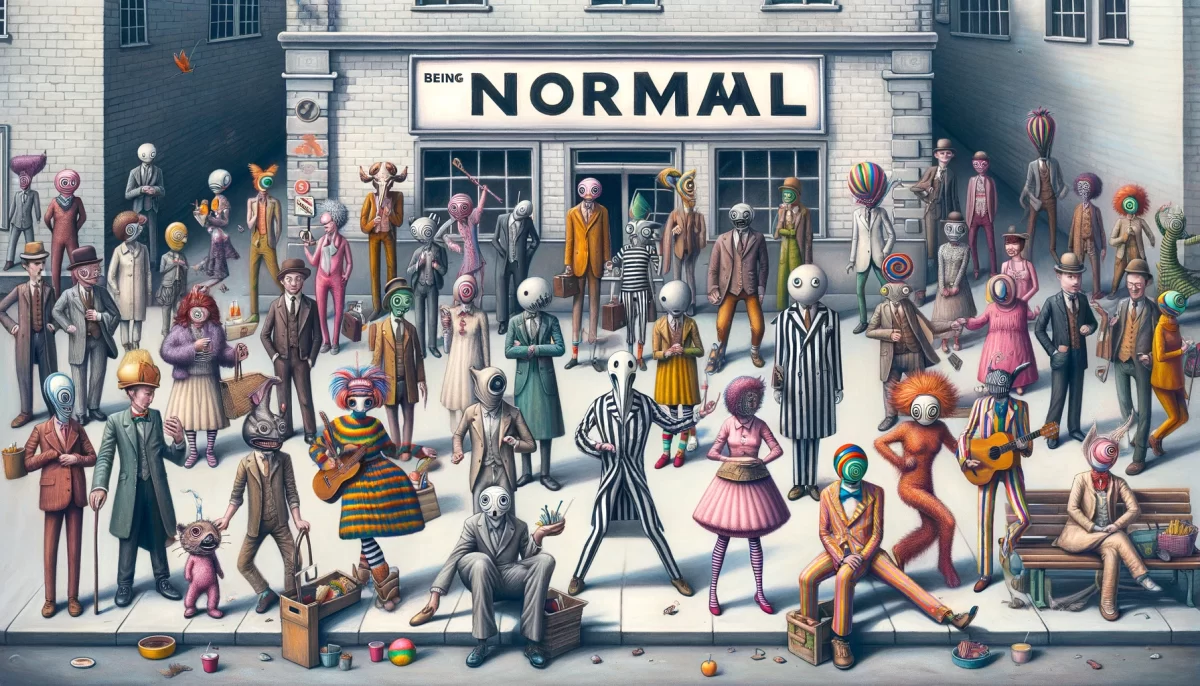





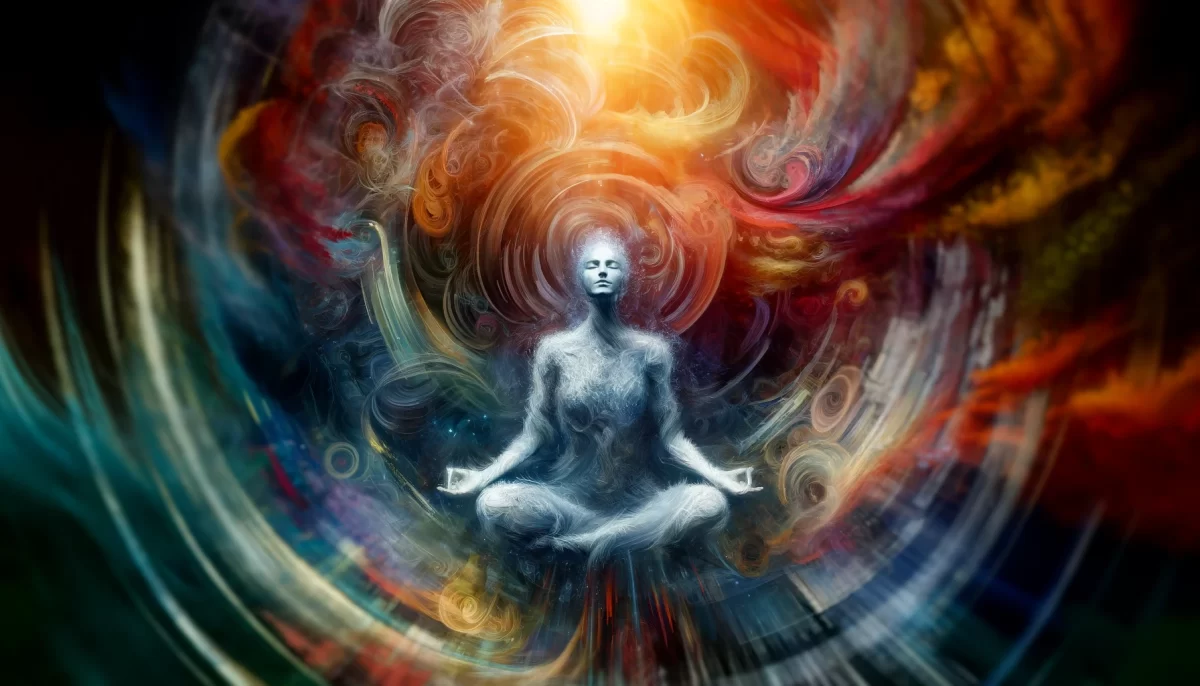






Leave a Reply